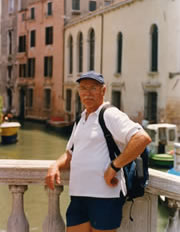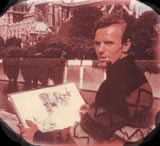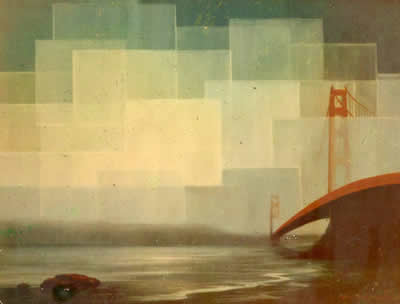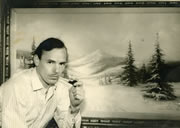
Biography of Victor Horvath Victor on TV
Signature | Customized Art | Portraits | Landscapes | Seascapes | Murals | Pets
It is very important to read Victor's Biography,
so that you have a
better understanding
of why his ideas are literally 38 years ahead of their time.

Victor Horvath in Venice (Present Day)
Victor Horvath started to draw when he was five years old. By fifth grade, Victor was so talented at creating drawings that teachers asked him to begin taking special classes to enrich his natural talents. When Victor was 17 (1956), the Hungarian Revolution began. In fear of his life Victor was forced to flee his country. He left Budapest, Hungary for Alberta, Canada in 1957. Victor bought his first painting kit in 1958 while in Canada. With this kit he started painting mountain scenes in Jasper Park. He moved to Montreal in 1960. In 1961 he started taking life drawing art classes at the Montreal Museum of Fine Arts.
Victor moved to California in 1962, and took several fine art classes in San Rafael (Marine County) outside of San Francisco. After the Kennedy assassination (November 22, 1963) Victor left for Paris, France where he sketched several drawings of popular Paris landmarks (Eiffel Tower, The Notre Dame).

Victor Horvath Paris (1963)
He then traveled to Vienna, Austria to attend the Vienna Art Academy for the summer session in 1964. Victor's professors were so impressed when seeing examples of his original style that they offered him free classes at the summer session. The professors were impressed with his original style.
Victor asked his favorite professor at the Vienna Art Academy, "Professor Eisner, should I pick up on the modern arts or should I continue to study the classical arts?"
Professor Eisner responded, "You are better off to study classical art and master it. After mastering the classics learn to abstract the classics. By doing this you will have learned how to make the abstract function in a classical fashion."
This idea shaped Victor's future.
Victor then headed back to California where he opened a studio in San Rafael. In 1967, Victor Horvath invented his abstract fine art technique (following his professor's advice that he should master fine art before abstracting it). He called it Transparent Squares.
He used large brush strokes (3 1/2" brush) to create overlapping squares on a scene of the San Francisco skyline.
He then enlarged them and made them transparent.
He completed the painting by superimposing a classical realistic painting of the Golden Gate Bridge on the surface of his Transparent Squares.
Now, Victor had created a technique that abstracted classic art.

First Victor Horvath Transparent Squares Painting Golden Gate Bridge (1967)
Victor created the Transparent Squares to represent real space, dimension, and color emotion. The Transparent Squares act as an abstract foundation for a classic art painting. The foundation (Transparent Squares) consists of three dimensions. When adding a classic art painting (contains its own three dimensions) on top of the Transparent Square foundation it takes it beyond three dimensions. He can expand this as far as he wants to go, because he can add additional squares to the foundation. This creates limitless space. The squares can act as a foundation for any art form. Victor believed that to be a true artist he must use techniques of classic art . The beauty of Transparent Squares is that it uses classic art technique and adds an abstract foundation that removes the space limits of three dimensional classic art canvas. The only limit on the canvas would be a lack of imagination by the artist.

Second Generation Transparent Squares

Victor Horvath California (1965)
Victor moved to Florida in 1973, and started to work on The Great American Adventure (for the Bicentennial in 1976). Victor finished The Great American Adventure (A 40' by 20' mural) in August of 1976. This painting was revolutionary in several ways.
Size- 40 by 20 feet (when all canvases are connected).
Technique -Transparent Squares make the canvas dimensions infinite. This is why teachers and students are enthralled, mesmerized, and galvanized by it.
Construction- It was was put together like a puzzle using 27 canvases as puzzle pieces (twenty three 4' by 8' canvases and four 4' by 4' canvases).
The purpose of The Great American Adventure was to commemorate the Bicentennial and also to inspire kids to learn more about history and art. Victor's belief is that learning history is a key to having a successful life. He believes humanity (the entire world) must learn from its past mistakes and past accomplishments in order to move forward into the future successfully.
Victor Horvath explains, "Without this knowledge children move forward in the world with blindfolds on."
By creating a major art work that inspires children's imagination (The Great American Adventure) he believed he could also teach kids this valuable lesson about history. Victor also made a rough draft of a book that explained his pictures (He included one or several paragraphs per painting). Victor also had photograph transparencies made of each painting when he hired a Florida based printing company to print 5000 posters in 1976. Victor's goal was to paint any material at any size, and he wanted to try and take the classical traditions one step forward (He did this with Transparent Squares in 1967). The Great American Adventure was his first example to show the world his new revolutionary technique.
Another revolutionary idea was to create one mural painting based on one subject matter. This mural would be one painting (created with transparent squares) made up of several canvases. The transparent squares would create the impression/illusion (why he goes by http://thenewimpressionist.com )of only one painting though many canvases would make up the mural. The viewer cannot tell it is more than one piece. It is still a revolutionary idea, because Victor Horvath remains the only artist with this technique. He is still waiting to paint these masterpieces.
"Imagine if I created something like The Great American Adventure, but created one painting (one subject matter) on the side of a large wall which contained multiple canvases. The painting would be created by combining multiple canvases, but it would appear that it is only one canvas. This is because my Transparent Squares would hide the cracks in between the canvases. One advantage is that it would add infinite dimensions, color, design to one single painting (made of several canvases). This would also allow mural paintings to become transferable from one place to another with ease. I could have created anything imaginable using this technique. This technique has no limits. It can be carried as far as my imagination will take it. I can teach fine art students to take it even further. Like history, it is important that the past forms of art are carried forward and combined with something new and different. There are no limits. I simply added my own technique to the classics. Without taking the past with us, we cannot move forward," Horvath explains.
However, the road to obtaining this goal was more difficult than Victor imagined. Four years after creating The Great American Adventure, it was on display at the 1980 Lake Placid olympics. One dreadful night a group of young children vandalized and destroyed it.
"This broke my heart," said Horvath."I created this masterpiece for the children and they destroyed my gift to them."
Twenty-two years later The Great American Adventure has resurfaced. Now it is being used by the public school system to teach American History to children just as Horvath had forseen. His rough draft book has become a published book that is now for sale on Barnes and Noble. It is known as Adventur-Cation™ (See below).
Even if it is 30 years late Victor Horvath is becoming the 21st century's Vincent Van Gogh. The significance of his trademark Transparent Squares is now starting to be realized. The Transparent squares are a perfect combination to move classic art forward, because it adds depth to art by extending the canvas into an infinite space continuum. His famous painting The Great American Adventure is an impressive example of his copyrighted Transparent Squares. His squares take children on an adventure ride using his art work which is based on historical people, objects, and events. That is why it is called Adventur-Cation. Adventur-Cation is another way to say Educational Adventures.
Adventur-Cation™
Victor Horvath founded Adventur-Cation™ when he painted The Great American Adventure. The public education system now uses his Adventur-Cation™ system (based on The Great American Adventure Painting and Book) to teach students US history. Adventur-Cation uses his Transparent Square mural paintings to catalyze learning. Victor Horvath's Adventur-Cation™ paintings are based on historical facts. It succeeds by creating memories through the repetitive association of Art with Fact. In more detail, Adventur-Cation™ works by associating Victor Horvath's Transparent Square Art with literary facts, sounds, videos, personal experiences, and primary source materials. The result of the Adventur-Cation™ program is an adventurous, unique, memorable, enjoyable, and educational process.
We owe Victor's artistic genius for its existence.